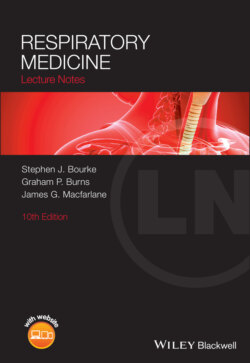Читать книгу Respiratory Medicine - Stephen J. Bourke - Страница 82
Peak expiratory flow
ОглавлениеPeak expiratory flow is the maximum rate of airflow that can be achieved during a sudden forced expiration from a position of full inspiration. The best of three attempts is usually accepted as the peak flow rate. It is somewhat dependent on effort, but is mainly determined by the calibre of the airways, and is therefore an index of diffuse airway obstruction. Its principal advantage is derived from its portability and low cost (Fig. 3.3). This allows multiple measurements to be performed independently by patients at different times and in different environments. Variability can thus be observed, which makes it useful in the diagnosis and monitoring of asthma (see Chapter 10).
Figure 3.2 Forced expiratory spirogram tracing obtained with a spirometer. (a) Normal. Four expirations have been made. Three of these are true maximal forced expirations, as indicated by their reproducibility. The FEV1 is 3.2I and the FVC is 3.8I. The forced expiratory ratio (FEV1:FVC) is 0.84. (b) Restrictive ventilatory defect. Patient with pulmonary fibrosis. The FVC in this case is 2I, less than the predicted value for the subject. The FEV1 is also reduced below the predicted value, but it represents a large part of the FVC. The forced expiratory ratio is >0.90. (c) Obstructive ventilatory defect. The FEV1 is much reduced. The rate of airflow is severely reduced, as indicated by the reduced slope of the curve. Note that the forced expiratory time is increased: the patient is still blowing out at 5 seconds. The VC has not been adequately recorded in this case, because the patient did not continue the expiration after 5 seconds; he or she could have expired further (this is a common technical error). (d) Severe airway obstruction. The FEV1 is about 0.5I. The FVC is also reduced, but not so strikingly as FEV1. Forced expiratory ratio is 0.23. Very low expiratory flow rate. This pattern of a very brief initial rapid phase followed by a straight line indicating little change in maximal flow rate with change in lung volume used to be thought to be indicative of severe emphysema, although identical results can be observed in severe asthma. (e) Airway obstruction and bronchial hyperreactivity. Five expirations have been made. FEV1 and FVC become lower with each expiration. Patient with asthma. These features suggest poor control of asthma and liability to severe attacks. (f) A non‐maximal expiration. Compare with (a). In a true forced expiration, the steepest part of the curve always occurs at the beginning of expiration, which is not the case here. A falsely low FEV1 and forced expiratory ratio are obtained. Usually, the patient has not understood what is required or is unable to coordinate his or her actions. Some patients wish to appear worse than they really are. This pattern is unlikely to be mistaken for a true forced expiration because of its shape and because it cannot be reproduced repeatedly. (g) Escape of air from the nose or lips during expiration. (h) Inability to perform the manoeuvre. Five attempts have been made. In some, the patient has breathed in and out. Other attempts are either not maximal forced expirations or are unfinished. Bizarre patterns such as this are often seen in patients with psychogenic breathlessness or in the elderly. Even with poor cooperation, it is often possible to obtain useful information. In the example shown, significant airway obstruction can be excluded because of the steep slope of at least two of the expirations, which follow an identical course and show appropriate curvature (dotted line), and the FVC can be estimated as not less than 3.2I. The pattern seen in large airway obstruction is shown in Figs 3.5 and 3.6.
